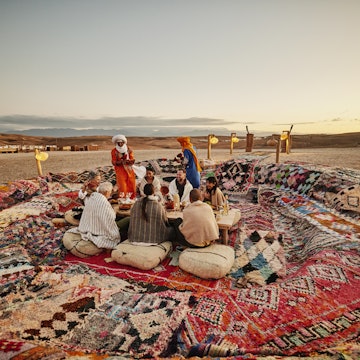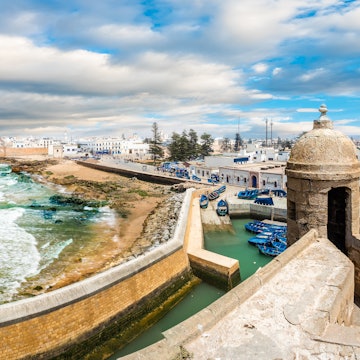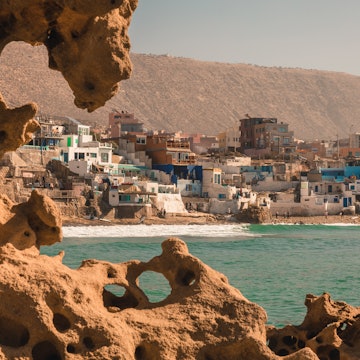
Marrakesh’s best neighborhoods: where to stay, shop and see the sights

Dec 15, 2023 • 5 min read

Even within the medina in Marrakesh, different neighborhoods will appeal to different types of visitors © David Prado / Stocksy United
Prepare to be wowed: Djemaa El Fna is the dazzling heart of Marrakesh, with hordes of people all day long and into the night. It’s an exciting place to be, with shops, restaurants, herbalists, cats, kids going to school, drummers, fruit-juice carts, motorbikes, groups of tourists, bugle-players, women going shopping, and the odd snake.
Emanating out from the plaza, narrow lanes unfurl into other neighborhoods, some quieter with good places to stay, some full of fascinating museums or marvellous monuments to explore, and some with smart boutiques and trendy restaurants. Beyond, it’s worth delving into the Ville Nouvelle (new city) with its glamorous art deco buildings for art galleries and chic boutiques, or venturing south of the city for a day’s respite in palm-fringed resorts.

Djemaa El Fna
Best neighborhood for soaking up the local atmosphere
This wide square is the pulsating heart of Marrakesh, where every visit to the red city starts. By day, the snake charmers’ piercing flutes and gnaoua drums sound out and the air is thick with burning incense, luring you into the mass of brightly colored fruit juice stalls, herbalists, henna artists, baskets and trinkets. By night, locals and visitors throng the food stalls set up in the middle of the square, appetites piqued by the smell of kebabs grilling over coals.
Around the edge are entertainers of all stripes – musicians and acrobats, men dressed as belly dancers, comedians, boxers and leaping gnaoua dancers, all watched over by the towering minaret of the Koutoubia. For great views and photo ops, climb to the rooftop of Zeitoun Café. Try out superb dishes in places you probably wouldn’t find by yourself on an evening food tour with Moroccan Food Tour. Continue the party with rooftop drinks at nearby Kabana, a sultry cocktail at Le Salama's "sky bar", or at Riad Monceau’s La Pergola Jazz Bar.
Mellah
Best quartier for exploring grand monuments, museums and pretty squares
Not all medina squares are as frenetic as Djemaa El Fna: head south to delightful, palm-fringed Place des Ferblantiers (Tinsmith’s Sq). Here you’ll find spice shops for rosewater, saffron or argan oil, Concept Bohem selling chic basketware and home decor, and some good places to eat: try Mazel Cafe for felafel and coffee or Kosybar for rooftop sundowners.
Within easy walking distance of Place des Ferblantiers are several major sights: glimpse the 15th-century power and glory of the imposing Badi Palace, now in ruins but well worth a visit. Don’t miss the beautifully decorated Bahia Palace with its courtyards and riads. Large houses, once owned by courtiers, abut these monuments: Dar Si Said, the carpet and weaving museum, and the Moroccan Culinary Arts Museum. And as the Mellah was the old Jewish quarter, a visit to the fascinating Lazama Synagogue and adjacent Jewish cemetery is a must.
The Mellah is an excellent place to stay as it’s just 10 minutes' walk from the action on Djemaa El Fna yet quieter with fewer tourists (and fewer motorbikes). Try the newly launched Zoraida Riad & Spa, elegant Riad Le Clos des Arts or art-filled Riad Azoulay.

Gueliz & Ville Nouvelle
Best for contemporary art galleries, chic boutiques and superb restaurants
A short taxi ride from the medina, the laid-back, trendy suburb of Gueliz in the Ville Nouvelle is perfect for exploring the art deco buildings of the new town built by the French in the 1930s. Some of these elegant buildings now house art galleries: marvel at the terrazzo floors and crystal light fittings of Comptoir des Mines as you peruse the contemporary Moroccan art on the walls. Passage Ghandouri on Rue Yougoslavie is a mini shopping mall bursting with showrooms and galleries. And do browse the tempting homeware at Some Slow Concept Store set in an urban villa. Follow the celebs into Norya Ayron’s exquisite clothing shop, and top off your outfit with a satin clutch from Lalla. Unwind with a drink at the sumptuous Grand Café de la Poste, followed by lunch or dinner at top-rated Plus61 or Cantine Mouton Noir.

Mouassine
Best neighborhood for spectacular architecture, superb guesthouses and relaxing hammams
Mouassine is known for its superb 16th-century Saadian architecture, from spectacular merchants' houses like Dar Cherifa to the sublime palace of Le Jardin Secret and its remarkable gardens. The exquisite Musée de Mouassine houses the Musée de la Musique, where concerts are held three evenings a week.
Just 500m north of Djemaa El Fna, Mouassine is one of the best neighborhoods for beautiful riads – stylish Riad L’Orangeraie, good-value Equity Point, or color-splashed El Fenn. Some of the medina’s best restaurants are here too: book early for a rooftop table at Nomad or La Terrasse des Épices.
After a hard day’s sightseeing, relax with a hammam and massage. Mouassine’s public hammam has recently been restored and services start at just Dh10 ($1) for a do-it-yourself hammam and rise to Dh150 ($15) if you include a massage. If you prefer a private spa, try the gloriously scented Hammam de la Rose or luxurious Le Bain Bleu.

South of Marrakesh
Best area to escape the city and relax at countryside resorts
For those days when you need to escape the city to find some tranquility and calm, head south to one of the countryside resorts. Beldi Country Club is one such haven, just 20 minutes’ drive from the medina, and features several pools (one for children), a restaurant and a bar in the olive-tree-filled gardens. There’s even a souq with some very special shops selling glassware, carpets, clothing, ceramics and jewelry. If you can’t bear to leave, there’s a hotel and two more restaurants.
La Ferme Berbère, with its adobe farmhouse feel and plenty of animals, also offers a day pass that includes the pool, lunch beneath the palm trees, a hammam and massage, as well as rooms if you want to stay.
Children will love the Oasiria resort with its eight pools sporting water slides and games, plus a pirate boat on a lagoon. There’s more adventure at Terres d’Amanar with its zip lines, forest adventure course, trekking, mountain biking and horseback riding.














